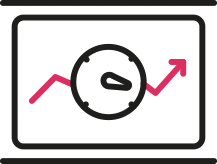You've made important investments in marketing data and MarTech software. Now, it's time to deliver on expectations.
The problem is, your team may be struggling to find the right data and put it to use in ways that produce the results you want, without overpowering your resources. You are not alone! While nearly 80% of executives want to improve their digital customer experience, only 10% report that their customer data and tools are working well to reach that goal! Of those surveyed, 47% identified fragmented customer data and siloed systems as the main culprits.*
While the solution may seem to be a complete overhaul of your marketing and sales operations, there are alternatives. We recommend a blend of available intent data and customer data platform (CDP) technology in novel ways that apply the most relevant data in fully automated scenarios to solve common marketing operations challenges. We call our approach Customer Data Orchestration.
Customer Data Orchestration uses a customer data platform to combine multiple data sets and unify them at the contact level, so that duplicates, errors and inconsistencies are eliminated and all connected applications use the same data.
Let's explore more details about customer data orchestration.
Set up personalized chat bots for target accounts and key contacts to engage them when they visit
These strategies depend on accurate data that is organized for dynamic segmentation to make sure that every touchpoint is personalized in ways that make sense to the buyer and encourage them to take the next step in their journey.
Fixing just one or two of the challenges usually fails to deliver expected results. For example, "plugging in" a marketing automation platform may speed up delivery of email or advertising, but without considerable data preparation, campaigns can suffer from poor engagement and inconsistent results.
At the heart of customer data orchestration is a customer data platform, or CDP. Over the last couple of years, CDP providers have grown in number, including many vendors of similar solutions that have rebranded to capitalize on the intense interest surrounding the term. In fact, many companies that think they have a CDP don't - at least according to the definition created by the CDP Institute!
How can you evaluate them and choose the right solution for your organization?
Let's start by defining what a customer data platform is all about.
Marketers want control of their customer data. Ideally, they want a database that collects and integrates data across all the business systems that manage and record customer touchpoints. It is not enough to just sync or consolidate data in one place.
Marketers also require an accurate and consistent record (a single customer view) for each contact and for this data to be available to all marketing applications and processes. To do this, you need a customer data platform, or CDP.
Many applications call themselves a CDP, but, according to the CDP Institute, the essential features include:
A CDP can be purchased and operated by the marketing department, with minimal assistance from other departments. Marketers can take full advantage of its capabilities, without needing the same technical knowledge as data scientists. A CDP streamlines and simplifies marketing operations.

A CDP unifies customer data from diverse business systems. including CRM, website, email, third-party data, legacy systems, etc. A CDP stores its own copy of the data, rather than shuffling it between applications. A CDP brings together siloed data, merging it into unified customer records.
Customer data platforms are similar to what we used to call "company databases". They are an umbrella for your sales-marketing-service stack and operate as central repositories, but they do much more. Let's examine some of the most important functions provided by a CDP in your MarTech ecosystem.
It's in everyone's best interest to comply with data privacy regulations and afford your visitors the customer experience they desire. A big part of that, moving forward into the 2020's, is honoring their rights and preferences when it comes to customer data storage, processing, and use. Few marketing data systems, and very few CDPs, have built-in, easy to manage applications for customer data privacy management. Our CDP helps you comply with GDPR, CCPA and more by allowing you to manage data privacy throughout the customer journey.

It's to your advantage to combine data from multiple sources in order to fully understand your prospects and customers. First-party intent data, from your website, email, ads, and social sites, tells you how people engage with your brand. Third-party buyer intent data gives you insights into what they are doing elsewhere on the web, including engaging with content topics and competitors, attending events, following influencers, and more. Enrichment data fills or updates customer profiles to add context and accuracy. Ad performance data gives you feedback on campaign or channel attribution.
The problem with all of this data is that it comes from different sources and is often formatted differently or has inconsistent responses to the same questions. There may be duplicate contact or account records, or errors that need to be corrected. A CDP does all of this and much more.
Merging customer data from multiple sources adds new dimensions to customer intelligence, but it can be difficult to understand the relationships of data from different sources. That's why a single customer view is so important, to make sure that every type of data orchestration, from campaigns to individual email outreach to sales rep engagement, operates from a single, consistent data record for each customer or prospect.
That's one of the primary benefits of a CDP, merging all types of ingested customer data together into a single, accurate, complete customer record. This is also one of the main weaknesses of trying to use a CRM or marketing automation system as a "source of truth" for customer data, since most of them do not have the ability to automatically create single customer views from diverse data sets. Our CDP does this effortlessly.


You might be looking for an additional way to find high-quality pipeline opportunities and convert them into customers.
Using a CDP to combine third-party and first-party intent data helps you identify high-priority prospects and qualify them based on fit, intent, and engagement. You can create a scoring system that prioritizes and segments these leads for assignment to your sales team or for a variety of lead nurturing campaign types - all centrally orchestrated, across your various execution systems, from your CDP!


Fully orchestrating customer data from a variety of sources, including intent data, can involve a variety of data operations. Our customer data orchestration solution, using a CDP, allows marketers to master data management and analysis, minimizing the resources required, and quickly organizing the right contact information for demand generation campaigns, personalized emails, and messaging for improved sales engagement.
Examples of how customer data orchestration benefits your marketing operations include: